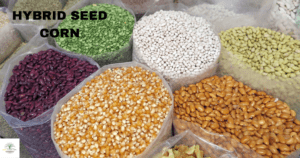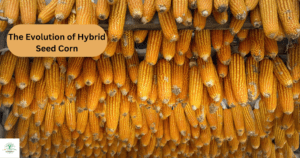The Evolution of Hybrid
Seed Corn: A Game-Changer in Agricultural Productivity
 |
Hybrid seed corn: Crossbred for vigor, uniformity, and yield. Harnessing hybrid vigor, it ensures robust crops with enhanced productivity.
|
|
Introduction
The development and commercialization of hybrid seed corn have
revolutionized agricultural productivity, making it one of the most critical
decisions farmers have to make. This article explores the history,
significance, and factors to consider when selecting corn hybrids. We will
delve into the process of hybridization, the impact of hybrid corn on crop
breeding, and the challenges associated with its adoption. By understanding the
evolution of hybrid seed corn, farmers can make informed decisions to optimize
their yield potential.
The Rise of Hybrid Seed Corn
In the early 1930s, hybrid seed corn emerged as a promising
innovation in agricultural productivity. Unlike open-pollinated varieties,
hybrid corn seeds resulted from the cross-pollination of two genetically
distinct inbred lines. This process, known as hybridization, led to plants with
improved characteristics and higher yield potential. The commercial success of
hybrid corn quickly gained momentum, with nearly 100% adoption in the Corn Belt
region of the United States by the late 1930s.
The introduction of hybrid corn marked a fundamental shift in the
role of public scientists in crop development. It paved the way for the
establishment of a transnational seed industry and transformed the relationship
between corn growers and their seeds. The genetic heterogeneity of hybrid corn
necessitated farmers to purchase fresh seeds each year, creating a symbiotic
relationship between seed companies and farmers.
The Science of Hybridization
To understand the process of hybridization, it is essential to
grasp the reproductive biology of corn plants. The male reproductive flower,
known as the tassel, produces pollen, while the ear serves as the female
reproductive flower. The silk, attached to each ovary on the ear, captures
pollen from the tassel, leading to fertilization and the development of corn
kernels.
Hybrid corn production involves selecting two different inbred
lines, designating one as the “male” and the other as the
“female.” These inbreeds are planted in the same field, typically in
alternating blocks of four female rows and one male row. The goal is to ensure
that only pollen from the male rows pollinates the ears in the female rows.
The Art of Data selling
To prevent unwanted self-pollination and maintain the purity of
the hybrid seed, the female tassels need to be removed. Mechanical machines
make several passes through the fields, cutting and pulling as many female
tassels as possible. Despite these efforts, a small percentage of female
tassels may still remain, requiring additional manual data selling.
Data selling is a labor-intensive process, often carried out by
school-aged children during the summer months. These workers meticulously walk
every row of female plants, pulling any remaining tassels that have grown
beyond the cut line. Field inspectors also conduct observations and counts to
ensure the removal of a sufficient number of tassels to maintain the desired
purity standards.
The Importance of Yield Trials
Selecting the right corn hybrids for specific growing environments
is crucial for optimizing yield potential. Yield trials offer valuable
information for making informed decisions. It is essential to consider
multi-location yield trial data that matches the field’s conditions, including
crop rotation, tillage system, soil type, and drainage.
When interpreting yield trial information, it is important not to
rely solely on the yield value itself. Instead, consider statistical measures
such as the least significant difference (LSD) or quartiles to evaluate hybrid
performance. High-performing hybrids that consistently rank in the top quartile
across multiple locations and years are more likely to demonstrate consistent
performance in the future.
 |
| Explore the dynamic journey of Hybrid Seed Corn, from its inception to modern innovations, revolutionizing agriculture with improved yields and resilience. |
Factors to Consider in Hybrid Selection
When choosing corn hybrids, several factors should be taken into
account to maximize crop productivity. These factors include yield potential,
disease tolerance, transgenic traits, early-season vigor and emergence, stand
ability and lodging resistance, green snap resistance, grain dry down rate,
seed costs, and the suitability for the specific cropping system.
Yield potential is a primary consideration, as high-yielding
hybrids have the potential to consistently deliver satisfactory yields. Disease
tolerance is another critical factor, especially for prevalent diseases in the
region. Considering the management practices and the likelihood of applying
fungicides is vital in selecting hybrids with suitable disease packages.
Transgenic traits, such as insect protection and herbicide
resistance, should be assessed based on the specific needs of the farming
operation. Early-season vigor and emergence play a significant role in achieving
the desired harvest population and minimizing disease risks. Stand ability and
lodging resistance are crucial for fields prone to wet conditions or late
harvest.
Green snap, a weather-induced phenomenon, can be managed by
selecting hybrids with proven resistance. The rate of grain dry down affects
harvest timing and drying costs, making hybrids with rapid dry down desirable.
Balancing seed costs with yield potential is essential, considering seed
discounts and alternative management strategies.
Utilizing Public Yield Trial Information
Public yield trial information from reputable sources like
universities and research institutions can provide valuable insights for hybrid
selection. Universities such as Iowa State, University of Illinois, University
of Nebraska-Lincoln, University of Minnesota, University of Missouri, South
Dakota State University, and University of Wisconsin conduct extensive research
and provide reliable yield trial data.
It is also beneficial to explore neighboring states’ yield trial
information with similar growing conditions. Additionally, public and private
strip trials, FFA club trials, cooperative trials, and seed company trials can
offer additional insights. While these sources may lack the replication found
in university trials, they can still provide valuable information for hybrid
selection.
https://www.kissanghar.pk/products?category=Hybrid-Seeds&subcategory=Hybrid-Corn-Seeds
Conclusion
The evolution of hybrid seed corn has significantly impacted
agricultural productivity and transformed the seed industry. The process of
hybridization, deta selling, and the selection of suitable hybrids based on
yield trials and specific field conditions are essential considerations for
farmers. By carefully evaluating the factors that influence hybrid selection,
farmers can optimize their yield potential and contribute to the sustainable
growth of the agricultural industry.
Remember to always consult local experts and agronomists to tailor
hybrid selection decisions to your specific farming operation. By staying
informed and adapting to changing conditions, farmers can harness the power of
hybrid seed corn to enhance their productivity and contribute to the global
food supply.


